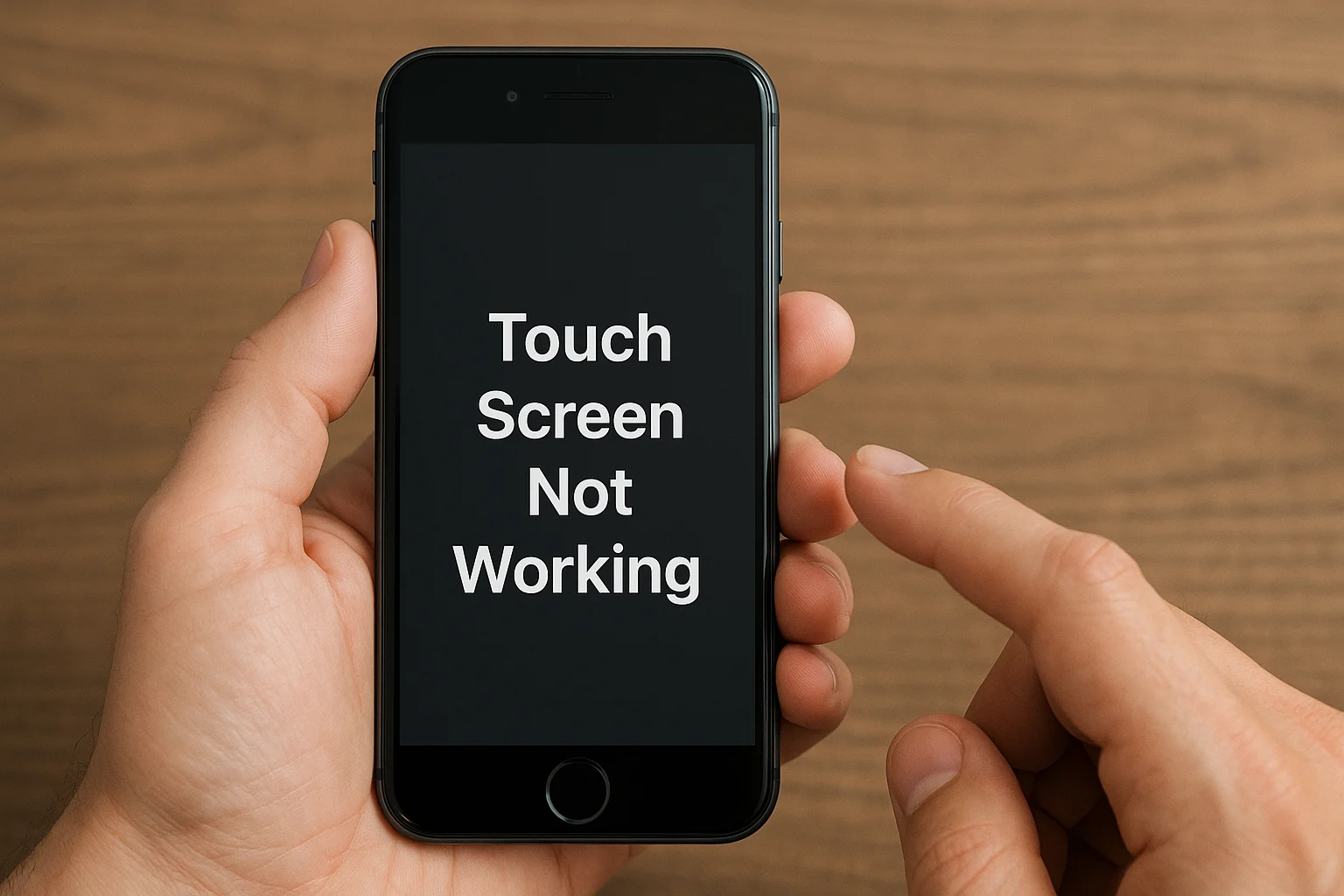An unresponsive iPhone screen can disrupt your day. This guide explains how to fix the issue, back up your data, and consider a refurbished iPhone.
Key Takeaways:
The iPhone touch screen not working includes:
- Unresponsive screens can be due to software, hardware, or physical damage.
- Start with force restarting, cleaning, and updating your phone.
- If issues persist, consider backing up your data or restoring the device.
- A refurbished iPhone may be a cost-effective replacement.
Introduction:
Dealing with an unresponsive iPhone screen can be frustrating. Whether it’s freezing or unresponsive to touch, it can prevent you from using your device efficiently. Fortunately, there are several methods to troubleshoot and fix the problem.
By following the right steps, you can restore your phone’s functionality without needing immediate professional help.
In some cases, a refurbished iPhone could be a great alternative if repairs are costly.
Read more: iPhone Guide: Master Your Device with Easy Tips and Tricks
Table of Contents
How I Helped a Client With iPhone Touch Screen Not Working
A client reached out when their iPhone 13 stopped responding to touch after an update. They tried restarting the phone, but it didn’t help.
After a quick check, I walked them through a few steps: cleaning the screen, updating iOS, and performing a forced restart.
After these fixes, the screen started responding again. In some cases, the issue may seem small, but knowing the exact steps to take can make a big difference.
Read More: iPhone Troubleshooting: How to Fix iPhone Issues Fast
Why is Your iPhone Screen Not Responding?
Several factors could be causing your iPhone’s screen to stop responding to touch. Identifying the root cause is key to solving the issue.
- Software Glitches: Temporary bugs or conflicts in iOS can freeze the screen or cause it to become unresponsive.
- Physical Damage: Cracks, moisture, or impacts can affect the screen’s functionality.
- Dirt and Debris: Dust or moisture on the screen can cause touch sensitivity issues.
- Incompatible Accessories: Sometimes, cases or screen protectors can block the touchscreen’s sensitivity.
- Outdated Software: Running outdated iOS versions may cause touchscreen issues.
- Hardware Failures: If the internal components, like the digitizer, malfunction, it can lead to touch issues.
Table: Common Causes for Unresponsive iPhone Screens
| Cause | Description | Solution |
|---|---|---|
| Software Glitches | Temporary bugs or conflicts in iOS | Force restart, update iOS |
| Physical Damage | Cracked or damaged screen | Repair or replace the screen |
| Dirt & Debris | Smudges, dirt, or moisture on the screen | Clean screen with a lint-free cloth |
| Incompatible Accessories | Screen protectors or cases interfering | Remove accessories to test the touch function |
| Outdated Software | Running an old version of iOS | Update to the latest iOS version |
| Hardware Failures | Issues with internal components | Visit Apple support for repairs |
Knowing the cause allows you to choose the right solution.
How to Fix an iPhone Touch Screen Not Responding
There are a few quick fixes you can try to get your iPhone working again. Here’s a step-by-step guide.
Force Restart Your iPhone
One of the easiest fixes for an unresponsive iPhone screen is to force restart the device.
- For iPhone 8 and newer: Press and release the Volume Up button, then the Volume Down button, and hold the Side button until you see the Apple logo.
- For iPhone 7 and 7 Plus: Press and hold the Volume Down and Side buttons until the Apple logo appears.
- For iPhone 6s and earlier: Press and hold the Home and Side (or Top) buttons until the Apple logo appears.
This process resets the device and clears temporary software glitches.
Clean the Screen and Remove Accessories
A dirty or wet screen can cause the touch functionality to fail. Use a soft cloth to clean the screen. Also, remove any screen protectors or cases to see if they’re interfering with the screen’s sensitivity.
- Tip: Make sure the screen is completely dry to avoid moisture-related issues.
Update iOS
Sometimes, an outdated iOS version can lead to performance problems.
- Go to Settings > General > Software Update to check for updates.
- If the screen is completely unresponsive, connect your iPhone to a computer and update through iTunes or Finder.
Check for Physical Damage
If your iPhone has visible damage like cracks, it could be the cause of the issue.
- In this case, you may need to visit an Apple Store or authorized service provider to repair or replace the screen.
Restore Your iPhone Using Recovery Mode
If the screen remains unresponsive, restoring your iPhone in recovery mode may fix the issue.
- For iPhone 8 and newer: Press and release the Volume Up and Down buttons, then hold the Side button until you see the recovery mode screen.
- For iPhone 7: Press and hold the Volume Down and Side buttons until you see the recovery mode screen.
- For iPhone 6s and earlier: Press and hold the Home and Side buttons until the recovery mode screen appears.
Once in recovery mode, choose Restore to reset the device to its factory settings.
How to Back Up an iPhone with an Unresponsive Screen
It’s important to back up your data if your iPhone screen is unresponsive before attempting any fixes.
iTunes or Finder Backup
- Connect your iPhone to a computer and open iTunes (on Windows) or Finder (on macOS).
- Select your device and click Back Up Now. This will ensure your data is safe, even if you need to restore or repair the phone.
iCloud Backup (if Screen Works Intermittently)
- If your screen works for a short time, go to Settings > [Your Name] > iCloud > iCloud Backup.
- Tap Back Up Now to save your data.
Should You Buy a Refurbished iPhone If Your Screen Can’t Be Fixed?
If your iPhone screen cannot be fixed or replaced for a reasonable price, buying a refurbished iPhone could be a smart move. Here’s why consider it:
- Fully Tested and Certified: Swappie thoroughly tests all refurbished iPhones, ensuring quality. If needed, screens are replaced.
- Warranty Included: Every refurbished iPhone comes with a warranty, so you can buy with confidence.
- Eco-Friendly and Cost-Effective: Opting for a refurbished iPhone reduces e-waste and saves money.
A refurbished iPhone from Swappie might be your best bet if your current device is beyond repair.
Pro Tip:
If your iPhone screen is intermittently unresponsive, it could be due to outdated software. Ensure your iOS is updated regularly to avoid performance issues that may cause touch sensitivity problems.
Expert Quote:
A common mistake is overlooking minor software glitches when troubleshooting an unresponsive screen. Always start with simple fixes like force restarting before considering hardware repairs.
says tech expert, Mark Johnson, Apple Specialist.
Conclusion: Fixing an iPhone Screen Not Responding to Touch
An unresponsive iPhone screen doesn’t have to mean the end of your device. Start with simple solutions like force restarting, cleaning, and updating.
If that doesn’t work, consider restoring the phone or seeking professional repair. If the issue persists and repairs are expensive, buying a refurbished iPhone could be an affordable and reliable alternative.
If your iPhone screen is unresponsive, try the steps above and get your device working again. If repairs are out of reach, explore Swappie’s refurbished iPhones for a smart solution today.
Frequently Asked Questions
Why is my iPhone screen unresponsive even after a restart?
If your iPhone’s screen remains unresponsive after a restart, check for physical damage or dirt on the screen. You might also need to restore the phone using recovery mode or update the software.
How can I fix my iPhone if the touch screen works in some areas but not others?
Clean the screen and remove any accessories that may interfere. If the issue persists, it could be a sign of physical or hardware damage, requiring repair or replacement.
Can I still back up my iPhone if the screen is unresponsive?
Yes, you can back up your iPhone using iTunes or Finder if the screen is not responding. If it works intermittently, you can use iCloud backup.
Citations:
Apple Discussion: Touch screen not working on my iPhone after iOS 18 update


